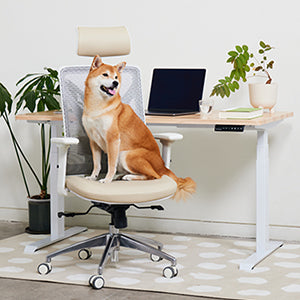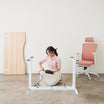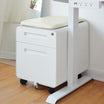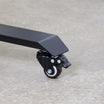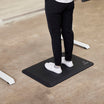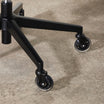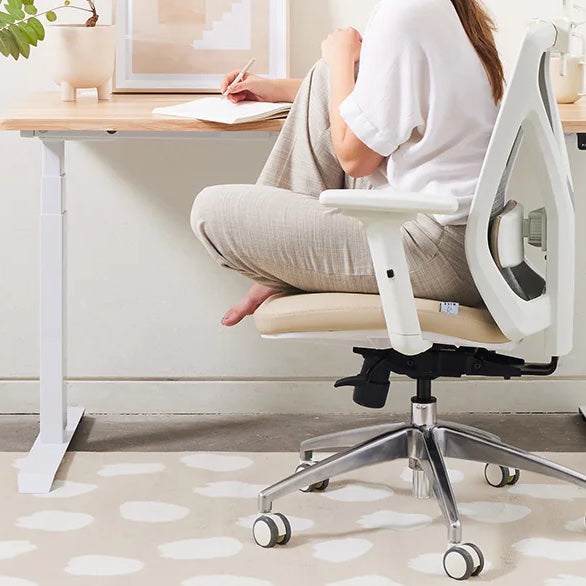When we think about ergonomic chairs, there are questions that come to mind: how comfortable will it be to sit in? Is it truly adaptable to every body type? There is one feature that when present in an ergonomic chair, ensures that your chair will have your perfect comfort level and fit. This feature is adjustable lumbar support.

How does it work and why does it matter?
Today, we will cover all you need to know when optimizing your ideal office chair.
What is Lumbar Support?
Lumbar support is a feature on an ergonomic chair designed to help you sit comfortably while doing activities that require you to stay seated for long periods of time. It usually comes in the form of pillows or cushions that help distribute weight evenly across the spine. Before we dive into it deeper, let’s start by looking at our anatomy.
Here is a demonstration on our Rise ergonomic chair:

Our back is supported by the spine, which is composed of 33 bones, called vertebrae, divided into five categories:
The Cervical
The Thoracic
The Lumbar
The Sacral
The Coccygea

We sit on them every day, and as they bear the brunt of our weight, they are constantly stressed. Throughout the day, our back gets strained by everyday activities like getting out of bed, walking around, and sitting down. At times, even seemingly benign tasks like typing or lifting something heavy can easily lead to injury if we aren’t careful. However, modern furniture is designed with ergonomic principles in mind, making it easier to stay healthy while performing common tasks.
The spine has a natural curvature, and lumbar support is predominantly concerned with maintaining this. Its main function is to help reduce the pressure on your spine and prevent muscle fatigue. It is made out of breathable materials that allow air to flow through them. These materials also wick away moisture and sweat to ensure that your body stays dry and cool.These supports are often used when sitting at a desk all day long.
Why is Lumbar Support Important?
Our bodies are made to move—we wouldn’t survive without them. Sitting for long hours costs us. Canadian statistics indicate that back injuries make up 28.8% of the lost time claims and 7.0% occur in clerical jobs. That’s one reason why ergonomics were invented — and why back supports got so popular.

Here are the factors that contribute to back pain in daily living:
improper posture
poor body mechanics
excessive static loading
repetitive motion
lack of physical activity
And getting an ergonomic chair with lumbar support can help you avoid all these.
As mentioned above, the lower part of the spine naturally curves inward towards the stomach when you are sitting upright. Having a lumbar support helps fill in the gap between the lower part of the spine and the surface below it. Sitting with your back supported encourages you to sit properly, reducing strain on your back. If you spend a lot of time at your desk staring at a screen your back may get stiff - this can put pressure on the discs in your spinal column and result in aches and pains. A well designed chair with lumbar back support will keep your back supple and healthy. These also help to prevent muscle strains and injuries. If you spend a lot of time in front of a screen, sitting all day, then you should consider investing in a modern office chair with lumbar support.
Where Should Lumbar Support Be on Your Chair?

Your lumbar support should sit in the middle of your back to keep your spine straight. To locate your lumbar support, run your hands down your spine and locate the point where your waistband sits in between your shoulder blades. This is usually about an inch or two above your waistline. Your chair should have elbow supports. This helps to prevent strain on the neck. Elbows should rest on the supports at a right angle. Knees should also be at a right angle.
There are some additional detail to enhance your experience:
Adjust keyboard and mouse to suit you
Screen should be adjusted to fit you.
Look for an ergonomic monitor stand instead of using the default desk stand.
You may need to move your monitor to achieve optimal viewing distance.
For shorter people, use a footrest to elevate your feet if it is required.
While seated in your chair, your eyes should look straight ahead at your computer.
Take regular breaks.
We all need to stretch our legs and flex our muscles, so get up and walk around at least every hour.
Who Needs Lumbar Support?
People who work in clerical jobs
People who sit for a long time(gamers, bloggers, etc.)
Those who experience acute and/or chronic pains in their backs
People with musculoskeletal disorders (joint and bone pain)
People who spend a large amount of time standing throughout the day
People who own office chairs without built-in back support
No matter who you are, whether you're a driver, a worker, a student or even a parent, your body goes through all sorts of pressure when you do everyday activities like driving your car and working. If there's anyone in your office who regularly sits at a desk for prolonged periods of time, they probably need some sort of back support.

Modern, effective office chairs come with lumbar support built-in. For anyone in your office who uses an office chair on a regular basis, lumbar support is an absolutely essential way to look after their wellbeing and long-term health.
Investing in a good office chair could be the ultimate remedy for your office work health, it is never too late to start.

